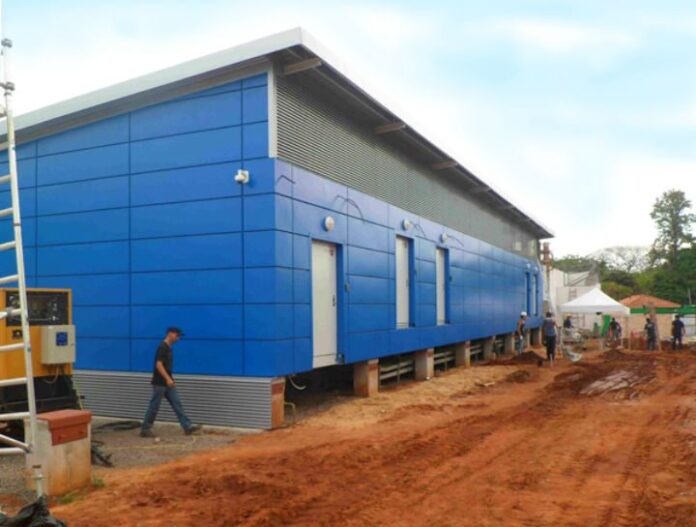With continued growth in the need for data centers, those looking to build must decide between a prefab or traditional build solution
The modern data center is a fully integrated machine. Systems that previously simply co-existed under the same roof are now expected to work seamlessly together. With the growing importance of data center infrastructure management, fine-tuning of a data center’s performance is the new norm.
At least this is how it should be. But while the individual components or systems in any given data center might be the same, the choice of building into which they are installed can have a significant impact on an operator’s ability to achieve this goal of full integration. And therein lies the question – whether to use traditional brick and mortar construction or a prefabricated modular build?
Brick and mortar
The perceived advantage of a traditional brick and mortar build is the design can be customized to the operator’s specific needs and expectations. However, while initially flexible on the drawing board, the design is typically fixed on construction making future alterations or expansion very difficult.
Brick and mortar construction is also very slow as it is by nature a linear process – preparing the site, doing the ground work, erecting the building, finishing the building, installing the equipment inside the building, installing all peripheral equipment around the site, completing the site and finally commissioning it. These are highly complex undertakings, with many dependencies and potential pitfalls. And a single minor delay at an early stage can have a significant impact on the overall time and cost of completing the project.
But the biggest single issue with respect brick and mortar buildings is that it is very hard to fully integrate them with the rest of the “data center machine.” Their traditional build ensures they continue to play their traditional role – that of a weather shell for the machine rather than being a fully integrated part of the machine itself. And that of course will limit the facility’s ultimate performance.
Pre-integration is the key
It is no wonder therefore that increasing numbers of operators are turning to prefabricated data center solutions. In prefabricated data centers, the building itself is as much a component of the machine as the cabling is, the power units, the cooling system or the server racks. And this allows for the full pre-integration and testing of all systems in a clean factory environment, with the result that you can be sure your data center is fully operational and optimized for performance before it ever reaches the site for final construction.
This pre-integration also has the added benefit that it is typically conducted end-to-end by a single supplier. This allows for the streamlining of component sourcing and the delivery of a turnkey solution with far less inherent risk than bringing multiple system vendors to site and hoping that they can work together without issue.
Ultimate flexibility and power usage effectiveness performance
To be clear, prefabricated data centers are not built with ISO containers. They are constructed with purpose-designed modules that can be configured for fully optimized open white space. This can include:
· High ceilings to accommodate higher raised floors, higher racks, higher power density, false ceilings for hot air containment, multiple cable layers, etc.
· Flexibility in floor dimensions with larger roof-spans (no pillars), caging possibilities and scalability in room size.
· Flexibility in floor utilization, providing the freedom to decide how to best place the racks in the available space.
· Different wall sizes and materials for placement outside or within an additional shell, different fire classes, different weather conditions and even to meet military requirements.
Like traditional buildings, prefabricated data centers can be designed to meet an operator’s precise layout and functionality requirements at day one. But unlike their brick and mortar counterparts, prefabricated facilities also have near limitless future flexibility. Just as power or cooling units are standardized blocks, modular data center systems have also evolved into standardized white space units that can be added to a data center as needed over time, without interrupting on-going operations in a live environment. So the initial build can be right-sized from the start and grown as and when necessary. And an added benefit of this modular approach is that matching specific cooling units to specific white space modules for specific data center utilization can achieve extremely low power usage effectiveness.
Speed to operations
The continuing global data boom is putting networks under enormous strain and capacity increases are often needed “yesterday.” We’ve already talked about traditional brick and mortar construction being an inherently slow sequential process. On the contrary, prefabricating a data center in a factory environment allows most of the high tech fit-out to take place in parallel with the site-based civil works elements, thus delivering a significantly shorter overall project time. And with construction skills and materials often being in relatively short supply in many parts of the developing world, the shipping in of a fully prefabricated building is typically the only way to ensure the fastest possible deployment of a facility of the highest possible quality.
Cost containment
The final nail in brick and mortar’s coffin is that of cost. The overall cost of many traditional building projects can often be excessively high both in terms of upfront capital expense justification and on-going operating expense planning. A prefabricated modular approach on the other hand allows for optimized short- and long-term financial planning and lower total cost of ownership.
The future is clear
The technology of prefabricating entire buildings has already evolved to the point that it is now a mainstream product and clearly the future of data center design worldwide. Prefabricated facilities combine the advantages of a traditional build without any of its pitfalls, while also ensuring controlled delivery, quality and overall project cost.
They can be custom-designed to a customer’s specific requirements; can scale horizontally or vertically as dictated by the site and by the operator’s capacity needs; can be designed to accommodate and fully interoperate with the latest data center technologies and systems; and are fully pre-integrated in a controlled factory environment. They can even be finished with façade cladding in any material to give them a high-tech look, a traditional look, or simply to better integrate them into their surrounding environment.
And most crucially, prefabricated construction enables the fine-tuning of a data center’s performance such that the new norm really is the new norm.

Jos Baart is VP sales and marketing at Flexenclosure, a designer and manufacturer of prefabricated data center buildings and intelligent power management systems for the ICT industry. Baart has more than 20 years experience in the global ICT industry. His previous roles include senior strategic business development, product marketing, sales and sales support positions at Ericsson (both country and group level) and at Lavastorm Analytics where he led the EMEA Sales function. Baart studied Electronics and Marketing Management in Eindhoven and Utrecht, The Netherlands.
Editor’s Note: In an attempt to broaden our interaction with our readers we have created this Reader Forum for those with something meaningful to say to the wireless industry. We want to keep this as open as possible, but we maintain some editorial control to keep it free of commercials or attacks. Please send along submissions for this section to our editors at: dmeyer@rcrwireless.com.

